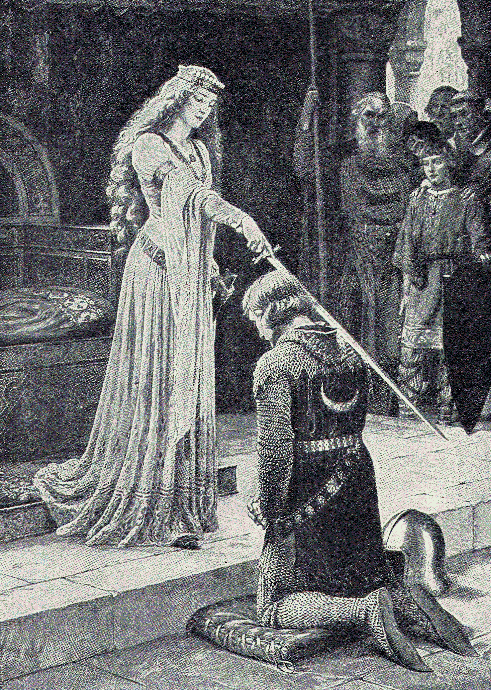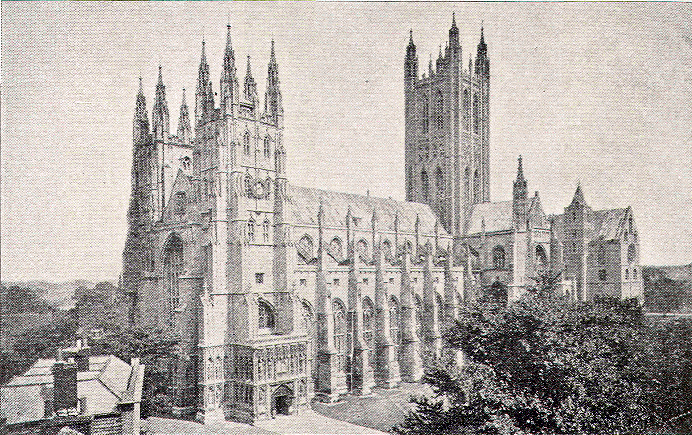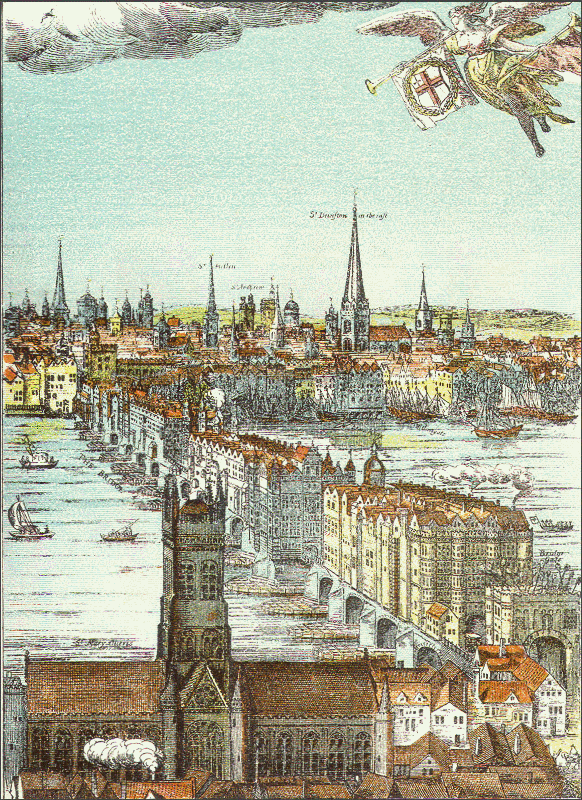


 |
 |

|
|
|
Overview of the
|

|
Pre-Modern Europe was a diverse group of states that were unified by a common religion rather than a powerful government. Its story can be told either by relating the particular stories of individual states within Europe or by focusing on themes common to all. Histories that take the thematic approach to European history usually cover the following topics, among others:—
- The Fall of the Roman Empire
- The Christianization of Germanic tribes
- Feudalism and chivalry
- Viking raids and Norse kingdoms
- The Moslem threat and the Crusades
- Church-state conflicts
- The Renaissance and revival of classical learning
- New World Exploration
- The Reformation
The thematic approach succeeds in covering the major aspects of European history common to all regions. Its major disadvantage is that it glosses over terrific differences in culture between the various states of Europe and the contributions of regional leaders, local saints, and national heroes.
Most of the books in the Heritage History collection focus on national rather than thematic history so the Heritage Classical Curriculum provides separate collections that feature the national histories of Britain, Spain, and Western Europe. All of the major themes of European history are covered in each of these collections, but in a specific and coherent manner that recognizes national heroes and events of local significance. This approach is appealing to younger students who can comprehend personal stories more easily than broad ideas. In British history, for example, the memorable stories of Augustine of Kent, Alfred the Great, and Richard the Lionheart personify such themes as Christian conversion, resistance to Viking incursions, and the Crusades.
Thematic histories of European history are valuable and the British collection includes several general histories of the Middle Ages. Most of the biographies, legends, adapted literature and historical fiction selections, however, refer specifically to British history. We suggest that each student read at least one general history of the European Middle Ages, but focus mainly on the specifics of Britain so that he or she may gain an in depth understanding of how the events of the Middle Ages forged modern Western culture.
Virtually all of the major themes of the European Middle Ages mentioned above are realized in the history of Britain. Like most of the rest of Western Europe, the British Isles were settled in prehistoric times by Celts and civilized by the Romans. The southeastern regions of Britain became a Roman province, although the wilds of Scotland and Ireland were never seriously Romanized. Soon after the Roman legions left Britain Germanic tribes from Saxony and Denmark swept in and over the next few centuries overwhelmed the native Celts. The territory settled by the Angle and Saxon tribes became known as England (Angle-land), while the Celts were pushed west and north, forming the nations we know as Ireland, Wales and Scotland.
Christianity had spread among the British Celts during Roman times and St. Patrick brought Christianity to the Irish just as Britain descended into its dark ages. Christianity did not begin to spread among the Saxons until the 6th century, but by 793 A.D., when the first Viking attack on English soil was recorded, most of the Saxon kingdoms were predominantly Christian. The Viking attacks posed an existential threat to the Saxon Kingdoms and mark the end of our first division of British History, Early Britain.

The Norsemen who assailed Britain were called "Danes" and their assaults continued for over two centuries until a Danish king actually ruled over England. The most important Saxon leader during this era was Alfred the Great, who restored England's fortunes both by defeating the Danes in battle and by making peace with those invaders who were willing to become Christians and settle permanently in Saxon lands. By the time the Danish king Sven Forkbeard drove the Saxon king into exile, most of the Danes both inside and outside Britain had been Christianized, so his rule over England was a peaceful one. A Saxon king, Edward the Confessor, regained the throne of Wessex after Danish rule, but he was the last of the Saxon kings.
In 1066 Saxon England was invaded by William the Conqueror, the Duke of Normandy, who brought with him the model of a powerful central government inherited from the Romans. Although the Normans had a tremendous influence on English government and laid the foundations for a powerful, centralized, monarchy, the culture and language of the country remained predominantly Saxon. The Norman line reigned for 90 years, but was superseded by the Plantagenet dynasty founded by Henry II, a great-grandson of William the Conqueror. The Rise of the Plantagenets marks the end of our second division of British History, Saxons, Danes, and Normans.
The Plantagenet kings reigned for over three hundred years, from the 12th through the 15th century. The dynasty produced many well-known kings and princes such as Henry II, founder of the line; Richard the Lionheart, hero of the Third Crusade; John I, a devious tyrant who was forced to sign the Magna Carta; Edward I, who conquered Wales and Scotland; Edwards III, who began the Hundred Years War; Henry V, hero of Agincourt; and Richard III, the villain of Shakespeare's greatest historical tragedy.
The best known wars of the Plantagenet reign were the Hundred Years War with France, and the War of the Roses. The Hundred Years War went well for England at first, but ultimately resulted in the loss of all English territory on the continent. The War of the Roses was a deadly civil war between the Yorkist and Lancastrian lines that lasted thirty years, killed off much of the royal family, and brought the Plantagenet dynasty to an end.

|
The Tudor reign ended near the turn of the 17th century when the throne was passed to James Stuart of Scotland, a nephew of Elizabeth. For the next hundred years England and Scotland were ruled as separate countries under the Stuart dynasty. Just as the Tudors are known as the reformation monarchs, the Stuarts are associated with the English Civil Wars, the struggle of parliament to gain predominance over the monarchy, and the rise of religious pluralism. The struggle between parliament and monarchy was resolved in favor of parliament when James II, the last Catholic king of England was deposed during the "Glorious Revolution" of 1688. In the final years of the Stuart era, Scotland and England were permanently united, and the rise of the British Empire began.
The final division of the British Middle Ages unit is the history of Scotland. Although several of the most famous characters of Scottish history, such as William Wallace, Robert Bruce, and Mary Queen of Scots, are introduced as part of English history, the complete story of Scotland is reserved for its own unit. Neither the Romans nor the English were ever able to subdue the ferocious Scots, who preferred their independence to vassalage under their wealthy and powerful neighbor. The story of Scotland is rich in local lore and clan rivalry, and when the pugnacious Scots did unite with England, it was as equals rather than a subject population.
The history of the Middle Ages and Early Modern period of British history came to an end when Scotland and England were united into the kingdom of Great Britain in 1707. The history of this period is divided into the following eras. Timelines, character lists, historical maps, and other information associated with each era are provided on additional pages.
| Era | Dates | Description |
| Early Britain | 40-800 | Roman conquest of Britain to first Viking raids |
| Saxons, Danes, and Normans | 800-1154 | First Saxon king of Wessex to death of last Norman king |
| Plantagenet Kings | Reign of Henry Plantagenet to War of the Roses | |
| Tudor England | 1485-1603 | Reign of Henry Tudor to death of Queen Elizabeth |
| Stuart England | 1603-1714 | Reign of James I of England to death of Queen Anne |
| Scotland | 483-1707 | Kenneth Macalpine unifies Picts and Scots to the Act of Union |
| European Middle Ages | 500-1650 | Rise of the Frankish kingdom to the Thirty Year's War |